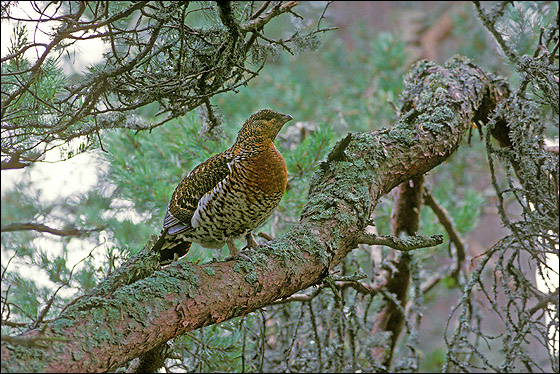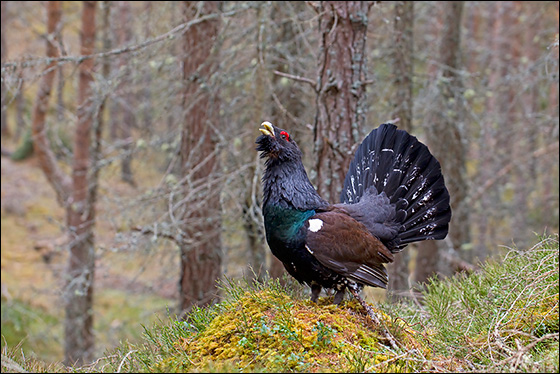Western Capercaillie (Tetrao urogallus)
Turkey-like in size and proportions, the Capercaillie is the largest of the grouse. Despite this it can be a difficult bird to see. The females are well camouflaged for hiding on the ground, and both sexes spend much time feeding quietly high up in the trees. In addition it is shy, so most encounters are of half-seen shapes careering away with a bolt from the foliage and a loud burst of wing-beats.
Capercaillies are almost entirely vegetarian, apart from a short period when, as chicks, they are insectivorous. In winter, when the ground is covered by snow, adults may spend up to five months in the tree canopy eating nothing but pine needles, shoots and a few cones. In the summer they come down to the ground and search for a much broader diet, including the leaves and berries of ericaceous plants such as bilberry (Vaccinium myrtillus) and bog whortleberry (V. uliginosum). These items are best found in rather open coniferous forest, with many glades and boggy areas intermixed, although in Spain the Capercaillie can be found in deciduous forest with an understorey of holly.
In late winter male Capercaillies become territorial, defending their patch of land with a unique song, quite like that of any other bird. It begins with tapping, accelerates to a brief drum-roll and ends in a pop, like a bottle of champagne being opened; a few loud belches may be added for effect. The performers initially start singing in the treetops, but later in the season, once dawn has broken, they come down to ground and strut about, with wings drooped and tails fanned. At times they can become very aggressive, with much fighting between rival males, often leading to injury and subsequent death. Birds intoxicated with aggression have been known to attack anything that moves, including birdwatchers, cyclists and passing deer.
The reason for their aggression is the meritocratic “lek” mating system, in which a small number of quality males obtain the lion’s share of copulations. Capercaillies have much larger lek arenas than Black Grouse, which may be 1km across, spread over an area of woodland. In common with other lek species, the sexes only associate for copulation, and thereafter the female is solely responsible for eggs and young.
From ‘Birds: A Complete Guide to All British and European Species’, by Dominic Couzens. Published by Collins and reproduced with permission.


